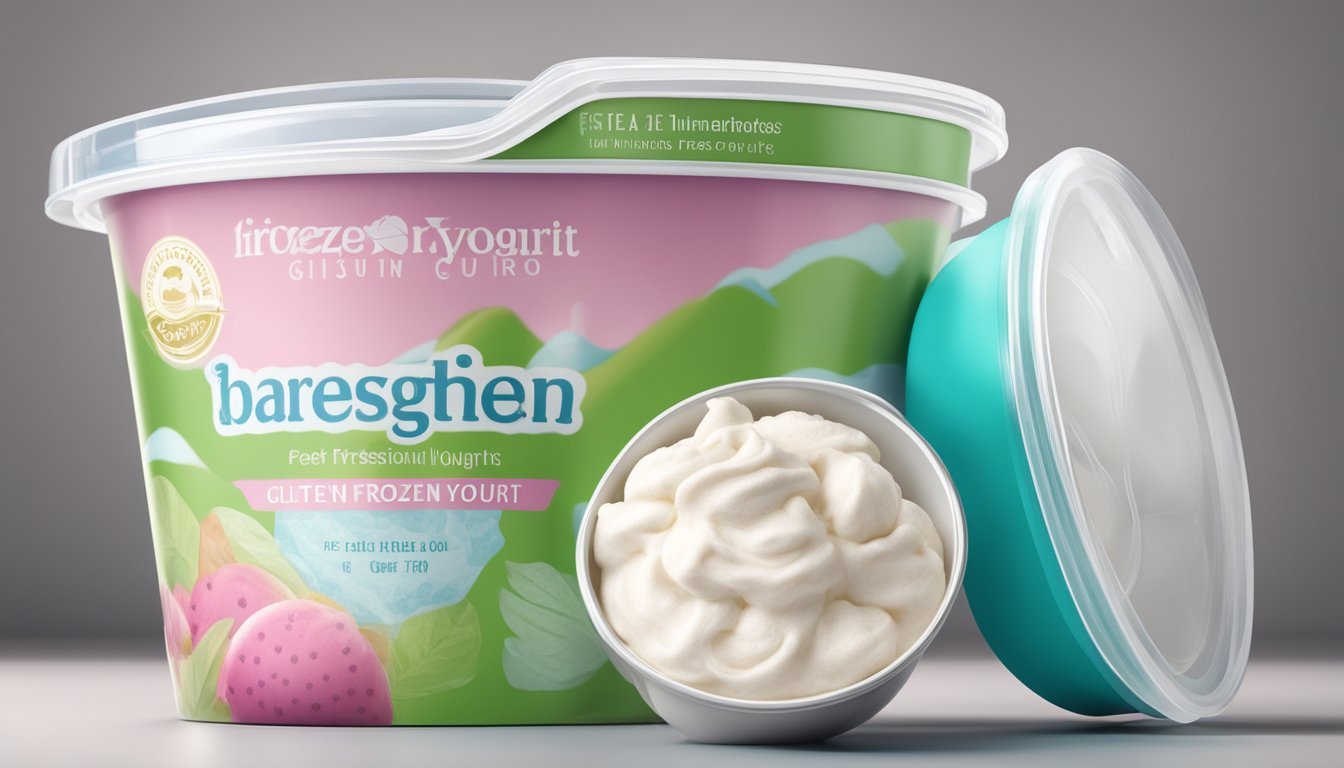How Long Does Gluten-Free Frozen Yogurt Last?
Storage Tips and Shelf Life
Frozen yogurt is a delightful treat enjoyed by many, especially those following a gluten-free diet. For those keen on understanding the shelf life of gluten-free frozen yogurt, the time it lasts largely depends on storage conditions and the specific ingredients used. Typically, gluten-free frozen yogurt can last in the freezer for 2 to 3 months if stored properly in an airtight container.
Factors such as the presence of fresh fruit toppings or other mix-ins can slightly alter its longevity. It's vital to keep it consistently frozen at 0°F (-18°C) or below to maintain its quality and safety. Regularly checking for changes in texture or an off smell can help ensure that the frozen yogurt remains fresh and enjoyable.
For the best experience, it is recommended to consume gluten-free frozen yogurt within the suggested time frame, while also keeping an eye on any signs of spoilage. This not only preserves its taste but also ensures that it remains a safe and delightful dessert choice for everyone.
Understanding Gluten-Free Frozen Yogurt
Gluten-free frozen yogurt is essential for those with celiac disease or gluten sensitivity. This section will explore what makes yogurt gluten-free, key ingredients to look out for, and the importance of yogurt cultures.
Defining Gluten-Free
Gluten-free products do not contain gluten, a protein found in wheat, barley, rye, and oats. This protein can cause severe reactions in individuals with celiac disease or gluten sensitivity.
For frozen yogurt to be gluten-free, it must be made without these grains. It's crucial to read ingredient labels and verify with manufacturers that their products are indeed gluten-free.
Ingredients in Gluten-Free Frozen Yogurt
The primary ingredients in gluten-free frozen yogurt typically include milk, sugar, and natural flavors. It's important to avoid additives that might contain gluten.
Common gluten-free flavors include vanilla, chocolate, and fruit varieties. Some brands even indicate gluten-free status on their labels, which can be reassuring for consumers.
Be wary of flavors with mix-ins, such as cookie dough or certain cereals, as these can introduce gluten into an otherwise gluten-free product.
The Role of Yogurt Cultures
Yogurt cultures, or the bacteria used to ferment the milk, play a pivotal role in making yogurt. These live bacteria help convert lactose into lactic acid, giving yogurt its distinctive tangy flavor and texture.
The bacteria used in yogurt cultures, such as Lactobacillus bulgaricus and Streptococcus thermophilus, do not contain gluten and are safe for gluten-sensitive individuals.
In gluten-free frozen yogurt, these cultures ensure the product remains safe and beneficial for people avoiding gluten. Proper labeling and certification help confirm that the fermentation process hasn't introduced any gluten-containing substances.
Factors Affecting the Shelf Life of Frozen Yogurt
Several factors influence the shelf life of frozen yogurt, including storage conditions, adherence to expiration dates, and bacterial activity due to fermentation.
Storage Conditions and Temperature Control
The most critical factor in determining the shelf life of frozen yogurt is how it is stored. Frozen yogurt must be kept at a consistent temperature of 0°F (-18°C) or lower to maintain its quality.
Any fluctuation in temperature can lead to ice crystal formation, affecting texture and taste. It is essential to always refreeze frozen yogurt immediately after each use to prevent it from staying at room temperature, which promotes bacterial growth.
Proper packaging is also vital. An airtight container helps to minimize the yogurt's exposure to air, maintaining its freshness longer.
Significance of the Expiration Date
Adhering to the expiration date on frozen yogurt packaging is crucial for ensuring safety and quality. While frozen yogurt can last beyond its expiration date if stored correctly, its taste and texture may degrade over time.
Consuming yogurt past its expiration date increases the risk of consuming harmful bacteria that could have developed despite freezing conditions.
It's advisable to label homemade frozen yogurt with the preparation date and monitor it regularly for any signs of spoilage, such as off colors and unusual odors.
Understanding Fermentation and Bacteria Growth
Fermentation plays a crucial role in the initial creation of yogurt, involving live bacterial cultures like Lactobacillus bulgaricus and Streptococcus thermophilus. These bacteria are essential for flavor and texture but can also impact the shelf life.
Although freezing slows bacterial growth, it does not entirely halt it. Over time, even at low temperatures, bacterial activity can continue at a minimal rate.
Understanding that the shelf life is impacted by how well the live cultures are managed can help in maintaining higher-quality frozen yogurt. Frequent checks for any changes in consistency or taste can give early warnings of spoilage.
Optimal Storage Practices for Frozen Yogurt
To maintain the quality and safety of frozen yogurt, proper storage practices are critical. Key considerations include using suitable containers, ensuring airtight seals, and maintaining ideal temperatures.
Packing and Contamination Prevention
When packing frozen yogurt, the choice of containers is essential. Opt for airtight containers to minimize the risk of contamination. Plastic containers with tight-fitting lids are a reliable option. It's important to fill the container as much as possible to reduce air exposure.
To prevent cross-contamination, thoroughly clean all utensils and surfaces before handling the yogurt. Labeling each container with the date can help track freshness. Additionally, consider using ice cube trays to freeze smaller portions. This method also allows for easy access and maintains the quality of the yogurt.
Refrigeration and Freezing Techniques
Maintaining the correct temperature is crucial for preserving frozen yogurt. It's recommended to store it at -18°C (-0.4°F) or lower. This ensures that the yogurt remains in a safe, frozen state. Setting the freezer to this temperature can prevent the yogurt from partially thawing and refreezing, which can degrade its texture and flavor.
For short-term storage, placing frozen yogurt in the coldest part of the freezer helps maintain a consistent temperature. Avoid placing the yogurt near the freezer door, as frequent opening and closing can cause temperature fluctuations.
If stored properly, frozen yogurt can last up to 2 months in the freezer without significant loss of quality. However, note that prolonged storage may slightly alter the texture, making it less creamy when thawed.
Identifying Spoilage in Frozen Yogurt
Determining whether frozen yogurt has gone bad involves checking for specific visual, textural, and olfactory signs. Knowing what to look for can help prevent the consumption of spoiled yogurt.
Visual and Textural Indicators
Mold: One of the most obvious signs of spoilage is the presence of mold. Look for green, blue, or black spots on the surface of the yogurt.
Texture: If the texture has changed significantly, it may indicate spoilage. Look for ice crystals forming on the yogurt, which can suggest freezer burn. A grainy or slimy texture is also a bad sign.
Separation: A little liquid separation is normal, but a lot of it, especially if accompanied by other spoilage signs, suggests the yogurt has gone bad.
Olfactory Signs of Spoilage
Sour Smell: The most common sign that frozen yogurt is spoiled is an off odor. A noticeably sour or rancid smell is a strong indicator that the yogurt is no longer safe to eat.
Unpleasant Aroma: Sometimes the smell might not be strictly sour but simply unpleasant or unusual. If the yogurt doesn’t have its typical fresh and mild scent, it’s best to discard it.
Health Considerations and Safety
When consuming gluten-free frozen yogurt, it is crucial to consider factors such as proper labeling and the risk of cross-contamination. These points help ensure the product's safety for individuals with celiac disease and other gluten sensitivities.
The Importance of Proper Labeling
For people with celiac disease or gluten sensitivities, accurately labeled ingredients are essential. The "gluten-free" label indicates that the product has been tested and contains less than 20 parts per million of gluten, meeting FDA standards.
Cross-contamination risks can arise if the production facility handles gluten-containing products. Therefore, a dedicated gluten-free facility or strict manufacturing protocols must be confirmed through the label or by contacting the manufacturer. The inclusion of a full ingredient list allows consumers to identify any potential allergens or gluten sources. This is especially important as some frozen yogurts may include wheat, barley, or rye as additives, which are not always apparent at first glance. Proper labeling ensures a safer consumption experience for those sensitive to gluten.
Culinary Uses of Gluten-Free Frozen Yogurt
Gluten-free frozen yogurt offers a versatile base for a range of creative recipes and pairs well with various gluten-free foods. Highlighting both traditional and innovative culinary applications can inspire delightful and safe dining experiences.
Creative Recipe Ideas
Gluten-free frozen yogurt can be reinvented in numerous ways to create refreshing and delectable treats. Smoothie bowls make excellent breakfast options when blended with fruits like bananas, berries, and mangoes. Topped with gluten-free granola and a drizzle of agave nectar, they can be both satisfying and nutritious.
Parfaits present another creative avenue. Layer the frozen yogurt with alternating levels of fruit and crushed nuts. This not only adds visual appeal but also offers a satisfying textural contrast. For an indulgent twist, consider folding in cocoa powder or nut butter for natural flavors that enhance the base.
When it comes to desserts, creating gluten-free frozen yogurt popsicles can be a fun and family-friendly activity. Blend the yogurt with pureed fruit and pour into molds for a delightful treat during warmer months. Add-ins like chocolate chips or shaved coconut can make these popsicles unique and enjoyable.
Pairing with Other Gluten-Free Foods
Pairing gluten-free frozen yogurt with the right foods can enhance its flavor and nutritional profile. Fresh fruits like strawberries, blueberries, and pineapple complement the tangy nature of the yogurt, providing a naturally sweet contrast. These combinations are both tasty and nutritious, suitable for snacks or desserts.
Gluten-free baked goods like cookies and brownies also pair well with frozen yogurt, offering a delightful mix of warm and cold textures. Freshly baked gluten-free waffle cones can add a traditional twist to serving frozen yogurt, making it a fun and nostalgic treat.
For a savory touch, consider pairing with lightly salted nuts or seeds, adding both crunch and a hint of saltiness that balances the yogurt’s sweetness. These pairings make the frozen yogurt versatile, fitting into various meal contexts from breakfast to dessert.
Product Insights and Market Trends
The gluten-free frozen yogurt market is witnessing significant growth due to rising consumer awareness and preference for healthier dessert alternatives. Understanding popular brands and consumer preferences is crucial for anyone interested in this market segment.
Popular Gluten-Free Frozen Yogurt Brands
Leading brands are capitalizing on the gluten-free trend. Red Mango offers a variety of gluten-free frozen yogurt options, attracting health-conscious consumers. Menchie's also provides gluten-free flavors, ensuring that they cater to dietary needs without compromising on taste. Pinkberry has expanded its product line to include gluten-free choices, highlighting its commitment to health and wellness.
These brands emphasize high-quality ingredients, often incorporating Greek yogurt and probiotics, which appeal to health-focused consumers. By prioritizing both flavor and nutritional value, these companies strengthen their market position and customer loyalty.
Consumer Preferences and Dietary Trends
Consumers are increasingly seeking out gluten-free products due to the rise in celiac disease and gluten sensitivities. This demand drives the market for gluten-free frozen yogurt. Health trends indicate a growing preference for low-sugar and high-protein options, making Greek yogurt variants particularly popular.
Dietary trends also reveal a shift towards more natural and organic ingredients. Consumers favor products that offer probiotics, which contribute to digestive health. As consumers become more health-conscious, the market for gluten-free frozen yogurt continues to expand, with brands responding to these preferences to stay competitive.
Key trends include:
Rising demand for organic and non-GMO ingredients.
Popularity of high-protein Greek yogurt options.
Interest in probiotics for digestive benefits.
Brands that align their product offerings with these preferences will likely see continued success in the growing gluten-free frozen yogurt market.
FAQs in the Context of Gluten-Free Yogurt Consumption
Many consumers have questions about gluten-free yogurt, especially regarding its safety and nutritional content. This section addresses those concerns with clear and concise information.
Addressing Common Questions
Is all yogurt gluten-free?
Most plain yogurts are gluten-free as they usually don't contain gluten ingredients. However, flavored or specialty yogurts may include additives like wheat, barley, or rye. It is crucial to check labels for gluten-free certification if you have gluten sensitivity.
Can yogurt labeled as gluten-free be trusted?
Yes, when a yogurt is labeled "gluten-free," it means it meets FDA standards and contains less than 20 parts per million (ppm) of gluten. This makes it generally safe for people with celiac disease or gluten sensitivity.
What about cross-contamination?
Cross-contamination can occur during manufacturing. To minimize risks, choose yogurts from brands that have dedicated gluten-free production lines or are certified gluten-free by reputable organizations.
Is Greek yogurt gluten-free?
Greek yogurt, like regular yogurt, is typically gluten-free unless additives are included. Brands like FAGE offer Certified Gluten-Free Greek yogurt options, ensuring their products meet strict gluten-free standards.
Does gluten-free yogurt have the same nutritional value?
Nutritionally, gluten-free yogurt is similar to regular yogurt. It provides essential nutrients, such as protein, calcium, and probiotics. Consumers with lactose intolerance should look for lactose-free options to avoid digestive discomfort.








